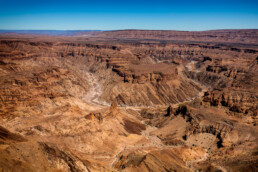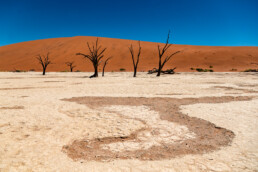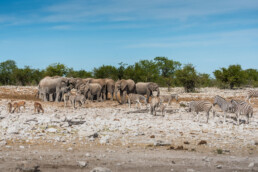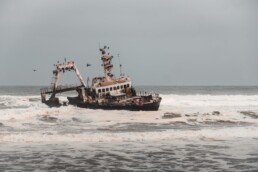September 2019 in Windhoek, Namibia:
Preparing for a 3-Year Overland Expedition Through Africa
Our first month in Africa has been quite frustrating and overwhelming. After learning so many new things about overlanding, camping equipment, Land Rovers and spare parts, we feel like we’ve been reborn as overlanders. Read on to catch the highlights and downfalls of preparing our car for a three-year overlanding expedition!
Monthly Recap Series From Africa
We decided to start a monthly recap series about what we’ve been up to and what we have achieved – and about the challenges so far.
Follow Our Daily Wins & Challenges in Instagram Stories
We do try to update especially our Instagram Stories daily so that you can follow our epic overland expedition through Africa in real-time. You can find us on Instagram @ExpeditionConservation and this is our Facebook page.
ARRIVING IN NAMIBIA IN SEPTEMBER 2019
We arrived in Namibia on August 30th with a lot of excitement and anticipation. Our goal for September was to prepare our car and ourselves for the 3-year overland expedition in just one month. Let’s see how we succeeded!
Meeting and Getting to Know Honey Badger, Our Land Rover Defender
We hadn’t seen our car, a 2009 Land Rover Defender 110 Puma before we finally arrived in Namibia. We found her on the last day we were in Namibia at the end of April, before flying back to Finland for the summer. We then bought her and handled all the paperwork with the help of our Namibian friends via email and Whatsapp. Yes, it was daring, but we didn’t have much choice.
At that point, we had searched for a suitable car for many months with the requirements that it should be a 4×4 made by Toyota or Land Rover. We found nothing in months and then on the last few days in Namibia around April we suddenly stumbled upon several suitable cars – including one Toyota Hilux by the side of the road in Swakopmund and our soon-to-be Defender on a Facebook advertisement. However, time posed strict restrictions then already, and we didn’t manage to do any test drives.
Oh yes, it was a massive leap of faith to buy a car without seeing it. Luckily, we had a few good friends who we trust checking the car for us, so we were able to proceed. We named our car the “Honey Badger”, after the true badass African creature who can survive almost anything. As a Defender, she can take us into the rugged African wilderness without giving a duck!
When we got back to Namibia at the end of August, we saw Honey Badger (also known as HB) for the first time. She was waiting for us at our friends’ house in Windhoek. It was so exciting! And it was even more exciting to drive a Defender for the first time – since neither of us had driven a Land Rover before!
A confession: it’s a totally different experience to drive such a big car. We had only driven regular cars before, though not for long – we both got our official driver’s licenses in May 2019!
LEARNING TO DRIVE A LAND ROVER DEFENDER
Learning how to drive a Land Rover Defender is a project of its own, for sure. There are so many things that you’ll have to do differently with a Defender.
The first time when we went on a drive, both of us were scared to death. But luckily, the fright wore off rather quickly, as we got used to handling our Honey Badger in the hectic traffic and narrow, crowded streets of Windhoek. More confessions: we watched a lot of YouTube videos for days to get a grip. But luckily, you can learn a lot from YouTube.
What we’ve learned about driving a Defender by far:
- You have to be gentle when changing gears (it’s a manual transmission, of course). Defender Pumas’ gear boxes are a little clunky, especially when you change from first to second gear. It’s a heavy-duty gearbox, so the shifts aren’t as smooth as with smaller cars.
- You can’t drive fast (never more than 100 km/hour with a Defender to save the engine, also try to avoid sudden accelerations and decelerations)
- You cannot do any quick movements: be gentle and smooth
- You need to control the clutch perfectly with a Defender (they are sensitive beasts). Clutch control gets even more important when off-roading from a hill start: the car should never slip backwards. Even a hilly city like Windhoek has given us nice clutch training. Being precise with the clutch helps a bit with the clunky gearbox, as well.
- You must anticipate the traffic as much as you can. To be honest, the brakes aren’t that good, and the Defender is a heavy car. It’s always better just let the engine brake and lower down gears well before intersections. You can bet that the locals hate us for being snails, when they are overspeeding almost all the time and then doing sudden decelerations at intersections.
- You gotta have patience! All cars are constantly overtaking us (even at solid lines, intersections, etc). Impatient taxi drivers are blowing horns (more than they usually do). Some may shout sometimes. But with a Defender, you just chill and don’t give a duck about them. Ommmm…
We feel that we’re slowly getting the hang of driving a Defender, although we still haven’t tried the low gears. But then again, they are for off-road driving only and here in Windhoek you don’t have much places where to go off-road.
To summarize: Land Rover is a slow-moving truck in city traffic. It’s more like a tractor, really. But we’ve already fallen in love with our Honey Badger. She might be slow, but she can go anywhere.
Learning New Things About Defenders and Their Maintenance
We have also learned many new things about Defenders. Especially Niina has spent countless hours reading different 4×4 forums and watching videos. For example, we know where to look for corrosion (a huge problem near the Atlantic coast and an unfortunate issue with Defenders).
We know which things to keep an eye for when driving in the bush (for example oil leaks and keeping everything tightly fastened on corroded roads). We still need more training, but we know that we can do this!
We’ll show you around Honey Badger during the upcoming weeks and tell more about Defenders in general. Just keep an eye on our social networks!
Up Next: Off-Roading
We are planning to have some proper 4×4 driving training before venturing off to the bush. We hope to do the first course already within a week and then explore Etosha National Park to learn more on our own. Then, we’re planning to do some sand driving lessons in the Namib Desert later in October.
Why haven’t we been able to do it yet? Well, because we still have not been able to gather all the equipment needed. We only got a good air compressor for changing the tire pressures a few days ago – and this is an essential tool before going on gravel roads.
So, what we’ve been up to then, besides learning to drive in a whole new way? Gathering and evaluating equipment for weeks!
THE MAIN CHALLENGES DURING SEPTEMBER: ROOFTOP TENT, BATTERY, AND LAPTOP
Everything didn’t go exactly as planned with our Land Rover Defender in the beginning. We bought HB in the belief that she had a good rooftop tent and a dual-battery system already in place. However, it turned out that the rooftop tent was rundown, missing poles and overall so dirty and old that we cannot use it. That was a major disappointment for us, as we had thought that we wouldn’t need to buy a new, expensive tent.
A bit later it also turned out that our Defender had only one battery, after all. One of our friends who checked the car for us had had a misunderstanding about the battery system. We just had an empty battery cover instead of the auxiliary battery.
The guy who sold us the car is a reliable lad and turned out to be extremely helpful with our aftersales issues. He hadn’t even checked the tent’s condition. He should’ve had, of course. And because we didn’t saw the car ourselves before buying it, we didn’t know. Buying the car without seeing it ourselves was a conscious risk that we took and it had some consequences. But there’s nothing much you can do about it than just deal with it.
So, we have to get a new rooftop tent. Good rooftop tents are costly, but luckily it seems now that we have managed to sort that thing out in a very positive way!
We cannot wait to tell you more about it – and to showcase our new “apartment”. At the moment we’re still trying to sort out how to ship the new tent from South Africa to Windhoek. That’s also a kind of a project on its own, but we hope to solve it during this week.
One of the most stressful challenges by far has been with Piritta’s MacBook Pro. It’s a long story and a long fight with Apple that we ended up losing. The laptop had a defect battery, which Apple promised to service in Finland within three weeks before we left (the laptop belongs to the defective battery batch of the mid-2015, so there was no way we could have flown with it).
Well, Apple totally messed up the service. Then, Apple promised to service the laptop in Central Europe and send it to Namibia before the end of September. Last week, they suddenly refused to ship the laptop here, against our written agreement.
Shipping the laptop from Finland to Namibia turned out to be nearly impossible, outrageously expensive, and a tiring process with a ridiculous amount of paperwork. We would have needed to declare the laptop (and pay customs), on top of paying for the freight. Then, we would have needed to get special permission to import it to Namibia (our local friends said that it’s practically impossible to get those kinds of papers here).
So, we came up with a new solution. Niina’s mum is flying here in November, bringing Piritta’s laptop with her and doing a little safari with us and Honey Badger – stay tuned!
We also decided that we could offer that kind of exclusive trips later on – would you like to join the expedition?!
If we get enough interested people, we could start planning the first, epic and exclusive adventure.
But please bear with us: we’re behind with work, as we have only one laptop to share. We’ll definitely do more updates, photos, and videos when we finally get Piritta’s MacBook Pro back in the beginning of November!
HONEY BADGER’S VISITS AT THE LANDY WORKSHOP IN WINDHOEK
We decided to take Honey Badger to a reputable Land Rover mechanic for “a final check” before leaving for the bush. First, the positives: HB had gone through major check-up and repairs before being sold to us, and we were happy to go through all the receipts.
We found a good Landy shop here in Windhoek, called Mobile Diagnostic Technician. It’s owned and run by Henry Bisschoff, the President of Namibia’s Land Rover Club. Henry has been very helpful and a great source of information.
On the first workshop visit, Honey Badger was oiled and lubricated all over and had some minor fixes done. Another shop had told us that our gearbox was leaking pretty badly, so we were expecting the worst. Luckily, it turned out that the transfer box had just a minor leak, which we need to watch (such leaks are among the common issues with Defenders).
Last week Honey Badger spent three days at the workshop again, this time getting a new dual-battery system with a solar panel.
We hadn’t been expecting to pay so much extra money for preparing the car. But in the end, these have been necessary preparations. We hadn’t originally planned to install a solar panel system but ended up doing it after thinking about it carefully.
The solar panel system will always keep our batteries charged up properly – and it’s an endless supply of free, sustainable energy. Besides the two car batteries, we can also charge our laptops, cameras, and phones on solar.
WHAT WE PLANNED TO DO IN SEPTEMBER BUT HAVEN’T MANAGED TO ACCOMPLISH YET
Originally, we had planned to get all the preparations done in September so that we could hit the road on October 1st. But rarely all things will go according to plan, especially here in Africa. Luckily we have already gotten used to the slow pace of Africa after recently spending seven months here.
In theory, we might have been able to leave on October 1st, if the rooftop tent would have been in good condition, HB would have had a dual-battery system from the beginning, we would’ve been able to find all the equipment much quicker and done some off-road rehearsals already, among lots of other minor things.
But as things didn’t go quite like that, we are now a bit behind the original schedule. Personally, it’s not a big surprise. In the end, we think that we’ll still have enough time in Namibia before our visas expire in late November.
And if we feel that we’d need more time, we can always go and apply for a visa extension. Here in Africa, you’ll never know how long extension you can get, but it’s still always worth a try.
WHAT’S NEXT?
Now in October we will continue gathering the last equipment still needed: some recovery gear and basic repair tools for the car, essential spare parts, and the remaining few camping gears. We will also need to learn some basic bush mechanic skills and off-road driving.
Henry from the local Land Rover Club has promised to teach us some repair and maintenance skills. We’re looking forward to learning from the expert!
As soon as we have the new tent (and have sold the old one), we will make our first test trip to Etosha National Park for a couple of days. We need to test all our gear and new skills in practice, and then decide whether we still need some more equipment or training.
During October, we’re also planning to visit Damaraland and its desert elephants and a couple of conservation projects here in Namibia. We’ll keep you updated!
Like described above, September was quite frustrating for us. It’s been very time-consuming trying to get all preparations done and fighting with the unexpected challenges. Many times we haven’t had any other choice than wait. Things just take time here in Africa. We have tried our best. And that’s all you can do.
Luckily, we can stay in Namibia at least until the end of November, so we will still have enough time to visit all national parks and wildlife conservation projects we have planned. Wish us luck – and that from now on things would go a bit more according to plans, will you?
MORE UPDATES FROM THE ROAD
We’ve just created a new YouTube channel, where we’re going to publish frequent video updates about Expedition Conservation. Expect stunning sceneries, close encounters with animals, heart-melting conservation projects, and stories from the road.






